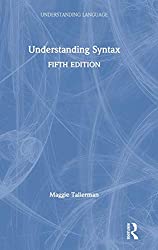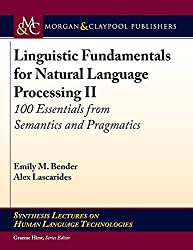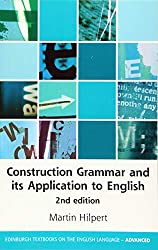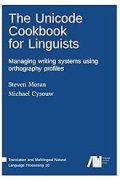
Rating: 8.5/10.
Overall impression: this book gives a well-rounded overview of syntax, good for an introduction and avoids most of the more theoretical issues. It’s split about 50/50 between English constructions and examples in other languages. This is a good balance, using English examples is easier to “ground” the theory to reality, while there are many ways that other languages are different from English.
Ch1: What is syntax?
Most syntax knowledge is innate and inaccessible to speakers, far beyond the few prescriptive grammar rules taught in school. A lot of common patterns across languages, for example, similar mechanisms for promotion in English and Indonesian (moving an object to more prominent position). Syntax is continuously changing: the do-support pattern of negation and questions gradually replaced the inversion pattern over a few centuries.
It’s important to use examples from other languages to illustrate diversity. To talk about languages we don’t speak, we use glosses. Lexical items are written in lowercase, and grammatical items are written in all caps. Use hyphens to separate morphemes in a word (eg: ask-ed = ask-PAST) but dot when a single morpheme contains multiple pieces of information (eg: took = take.PAST).
A basic aspect of syntax is word order, and English is usually SVO with fairly limited flexibility. Other marked (unusual) word orders are possible, to emphasize the object, or when the verb phrase is very long, it can get pushed to the end.
Ch2: Words belong to different classes
Three ways of distinguishing word classes:
- Morphosyntax: look at when morphological and syntactic rules can be applied. Eg: “very X”, has to be an adjective, “X-ing” has to be a verb.
- Distribution: gap where only members of a certain class can go there. Eg: “he ate the X”, has to be a noun.
- Function of the word in the sentence.
Nouns and verbs are cross-linguistically the most common word classes, and are usually open. Adjectives are sometimes a closed class. Other classes include prepositions, pronouns, conjunctions.
Verbs are used for predication (expressing events / states) and can be classified by argument structure (intransitive, transitive, ditransitive, etc).
- Tense expresses the event’s location in time (eg: past, present, future). Aspect expresses whether it’s ongoing (progressive) or completed (perfect).
- Mood expresses whether it’s a certainty, probability, possibility, etc.
- Valency-changing process: when a verb becomes passive (demotion), the argument structure changes. “my car was stolen” — here, the subject can be omitted when it would normally be obligatory in the active position.
- Agreement: a lot of European languages have subject-verb agreement, but some languages have agreement with object too.
Nouns have syntactic and semantic roles that don’t necessarily correspond to each other. Eg: “John sent a letter” and “John received a letter”, both cases “John” is the subject, but in the first he’s the agent, in the second he’s a recipient.
To determine if noun is a subject in English, two tests: (1) subject triggers agreement with the verb, and (2) nominative case for pronominal, ie, can replace the noun with “he” or “I” instead of “him” or “me”.
Some properties associated with nouns:
- Number: singular or plural (sometimes dual), often language distinguishes count and mass nouns.
- Gender: better to think of them as noun classes, since they only loosely correspond to anything semantic, and aren’t always masc/fem.
- Possession: often distinguish alienable from inalienable.
- Case: marks if it’s a subject or object.
- Determiner: sometimes marked as an inflection. In English, a lot of things can be determiners: wh-determiners (“which boys”), possessives (“his car”), pronouns (“you guys”). Chinese can use word order to mark definiteness.
Adjectives can be used attributively (“red car”) or predicatively (“the car is red”). Not every adjective can be used in both ways. A good test for adjective in English is whether it can be preceded by “very”.
Some languages have a very small, closed set of adjectives, and use verbs to express those meanings. We know they are verbs and not adjectives because they share the same morphology as verbs. Whether all languages has an adjective class is controversial.
Adverbs in English aren’t distinguishable by morphology, and occur in complementary distribution with adjectives, so they’re best considered as a sub-class of adjectives rather than its own word class. Sometimes, adjuncts are confused with adverbs (“I’m leaving today“).
Prepositions in English can be identified by whether they can be modified with “well” / “just”. Eg: “just under the bed”. Some languages have postpositions instead, and the umbrella term for both is adposition.
Different languages have different word classes, and it’s important to use objective criteria of morphosyntax to distinguish word classes within a language, and not assume artificial divisions simply because English has them.
Ch3: Looking inside sentences
A clause / simple sentence is a sentence that only has one predicate. Such a clause (not attached to any other) is called an independent clause. In English and many languages, a clause must contain exactly one finite verb: a verb that’s marked with tense information.
The finite verb might be an auxiliary like “do”. Some like (“can”, “must”, “should”) express permission / possibility / ability and are called modal auxiliaries; others like (“have”, “be”) are express time and are called aspectual auxiliaries. Many European languages have “have” / “be” auxiliaries, but other types of auxiliaries (eg: for negation) are possible.
Non-finite verbs don’t mark tense or agreement and can be divided into two main types:
- Infinitives: hard to define cross-linguistically, but in English they come after “to” or modal auxiliary, and must not be inflected. In French they have inflections -er, -ir, -re.
- Participles: verbs that co-occur with finite auxiliary. In English there are two types: -ing participles (“he was writing”) and past participles (“he has written”).
Complex sentences have more than one clause. If the clauses have equal syntactic status, then it’s called coordination (“John arrived early but Mary was late”, otherwise it’s subordination.
In subordination, the embedded clause is the subordinate clause, and the whole clause including the subordinate is called the matrix clause (<Lat: mother). A subordinate clause is called a complement if it’s obligatory for the verb (eg: “they expected to eat the cake“), otherwise it’s called an adjunct (eg: “they ate because they were hungry“). The complementizer (eg: that, whether) marks the embedded clause, and has selectional restrictions dependent on the verb.
The top-level clause in a sentence is the root clause / main clause. Some languages (German, Breton) have different word order requirements for the root clause. In English, root clause can’t usually have a complementizer; only root clauses can have subject-auxiliary inversion and tag questions.
Instead of subordination, some languages use nominalization, which turns the subordinate verb into a noun. Others like Chinese use verb serialization, where a chain of verbs are combined to make a complex event. This is differentiable from subordination because serial verbs share the same subject, negation, tense, aspect, etc.
Ch4: Heads and their dependents
The head of a phrase is the most semantically important one that the dependents modify. It can be substituted for the whole phrase and cannot be omitted (although some dependents also cannot be omitted).
Heads influence dependents in two ways. First, they select dependents with restrictions to a particular word class. Second, the head determines the type of agreement and case of its dependents (the process of triggering case of dependents is called government).
Complements are usually obligatory arguments for verbs, are selected for by the head, while adjuncts are optional and only have a loose relationship to the head. In English, complements usually come before adjuncts. Verbs can be classified into classes by what complements it takes: other than intransitive / transitive / ditransitive, they can also select for a specific preposition, or infinitive. It’s hard to give a list of verb classes. Other word classes like prepositions, adjectives, and nouns can also take complements.
The DP hypothesis states that the head of a noun phrase is actually the determiner. The determiner is clearly not the semantic head, but meets a lot of syntactic criteria for head: it’s the obligatory part of the phrase and has the same distribution as the whole phrase.
Languages can be classified by where the head occurs: head-initial (English, Celtic) or head-final (Japanese, Turkish). They can also be classified as head-marking or dependent-marking — an example of the latter is noun cases, which tell you the relationship of the dependent to the head.
Head-marking languages are most commonly found in the Americas and Australia / New Guinea, while dependent-marking is far more common (including the Indo-European family). A common feature of head-marking languages is bound pronominals: pronouns arguments that are affixed to the head.
A third possibility is zero-marking, like Chinese, where neither the head nor dependents are marked. English is largely this type too. One form of head-marking in otherwise dependent-marking languages is verb agreement with the subject.
Ch5: How do we identify constituents?
A constituent is a group of words in a sentence that form a sub-structure together. Some tests to see if a group of words is a constituent:
- Sentence fragment test: if it can be a sentence fragment, then it’s a constituent. Eg: “She bought the book with her own money“, if you ask “what did she buy“, you can respond “the book“, but not “the book with her own money“.
- Echo question test: check if you can replace the group with a question word: “She bought what with her own money?“
- Cleft test: check if you can move the group of words somewhere else: “It was the book that she bought with her own money“.
Possibly every language has displacement similar to the clefting example: the ability to move phrases from the basic position. Constituency structures can be drawn out in a tree structure, it’s essentially a representation of grammaticality judgements using these tests, since you must be able to defend that every subtree is a constituent.
English distinguishes phrasal verbs like “shake off” from prepositional verbs like “rely on”, where “on” is not part of the verb, but rather “rely” selects for a PP that must start with “on”. The test is check if you can swap the object: “shake the attackers off”. Therefore you can see their trees are different.
Another test is the co-ordination test: if two phrases can be joined with a coordinating conjunction, then they’re constituents of the same type. More advanced analysis deals with intermediate constituents denoted N’, like “her [treatment of the issues] and [sensitivity to the problems]”.
Ch6: Relationships within the clause
There are three main ways of indicating the relationships of dependents to the head: ordering, case marking, and agreement. Often a language uses a combination of them, but typically a language with case marking has more flexible word order.
Of the six possible word orders, SVO and SOV are the most common, followed by VSO; the other three are rare. It’s not always easy to determine the basic word order, especially for strongly head-marking languages. Strong correlation with SVO languages being head-initial and SOV languages being head-final.
Languages can be grouped by morphosyntactic alignment. Denote S = subject of intransitive verb, A = subject of transitive verb, O = object of transitive verb. Nominative-accusative alignment is when S=A, ergative-absolutive is when S=O. Ergative languages are less common, includes Basque, Tibeto-Burman languages, Mayan.
Ergative languages always have some parts of the grammar be nominative-absolutive: this is called split ergativity. The split can be on a variety of factors: pronouns, animacy, tense, etc. A rare type of alignment is tripartite where S, A, and O are all different. In almost all systems, it’s the S that remains unmarked.
A nominative-accusative language need not have a nominative case, it could just be present in the agreement system. The terms accusative / ergative just refers to the re-use of morphosyntax for intransitive and transitive verbs. Common to have ergative case system, but accusative agreement system.
Ways to define a subject cross-linguistically:
- Agent is usually the subject.
- Subjects tend to appear first (80% of languages SOV or SVO).
- Subjects are implicitly missing in the imperative form.
- Subject controls reflexive forms (-self, each other).
- Subjects can be omitted in co-reference (John met Tom and [GAP] talked to him).
- Subjects are the target for promotion.
It’s still debated whether subjects are a linguistic universal: problematic cases like Tagalog require some technical argumentation on whether something exhibits subject-like properties.
Another grammatical relation is the object, which is the target of passive constructions. In English, nothing to really distinguish direct and indirect objects, but some languages have markings only for direct object.
Some languages like Latin and Walpiri have very free word order, so you can have discontinuous constituents. It’s been argued that some languages don’t have constituents at all, and dependencies is more appropriate; however there is evidence of constituency in Walpiri.
Ch7: Processes that change grammatical relations
The passive construction is a very common grammatical process that has the following properties:
- Applies to transitive verb and turns it intransitive.
- Former object is promoted to subject.
- Former subject is demoted to oblique argument (“by X”) or deleted.
- Changes to morphology (past participle in English).
In ergative languages like Inuktitut, the case of the object doesn’t change when promoted to subject, because both are in absolutive case (only subject of transitive verb is ergative). But pragmatically it has a similar function of drawing attention to the promoted NP.
The impersonal construction is when the subject is dropped and made implicit, but unlike the passive, the object doesn’t get promoted to subject position. Eg: in Japanese, you can say “is big” and the subject is implied.
Ergative languages (and never accusative languages) have an antipassive construction, where the object is demoted to an oblique argument (or deleted), the verb becomes intransitive, and the subject changes from ergative to absolutive case. Although the word order doesn’t change, it has the effect of focusing the subject.
In ergative languages, absolutive case can be coordinated. Eg: in English “Alice saw Bob and returned” it means Alice returned, but in Dyirbal it means Bob returned, because both “Bob returned” and “Alice saw Bob” are in absolutive case. If you want to say “Alice saw Bob and (Alice) returned”, you can use the antipassive construction.
The applicative construction (also called dative movement in English) is when a PP gets promoted to direct object position, eg: “I baked a cake for Kim” -> “I baked Kim a cake”. Some languages allow this for a wider range of PPs (like instrumental PPs which isn’t allowed in English), some languages like French doesn’t have this at all.
The causative construction is formed with “made / let / have / cause” in English, eg: “we made the students leave”. Similar constructions exist in a lot of languages. In French, we get a serial verb “Nous avons fait lire le livre à Jean” instead of an embedded clause; in Korean there is a causative morphological marker that increases the valency of the verb.
Ch8: Wh- constructions: questions and relative clauses
In English, questions are asked by wh-fronting: putting a “wh” word like “who / where / when” and adding a dependency to the gap, and there can’t be anything else that fills the gap. Other languages (Chinese and Japanese) use wh-in-situ where the question word stays in place and does not move to the front. French allows both wh-fronting and wh-in-situ. When there are multiple question words, in English only one of them can be fronted, but Serbo-Croatian allows multiple fronting.
A similar construction is the relative clause, eg: “the teacher scolded the students who didn’t do the homework“. This restricts the students to a subset that the speaker wants to talk about. It’s similar to wh-fronting because there’s also a gap position. Most languages have relative clauses, although Piraha is claimed to lack them. In Japanese, there is no relative clause marker, it just comes before the main clause. In Bambara, the relative clause is not embedded, but an adjunct, so the main clause is valid as a standalone sentence.
There is a cross-lingual accessibility hierarchy for relative clause formation: subject > direct object > object of adposition > possessor > object of comparison. In English, pretty much anything can be relativized (although the last is marginally valid), but in Tagalog, only subjects can be relativized.
Focusing is another construction that has a gap, eg: “beans I like, but spinach I can’t stand”. Typically moving something to the front makes it more important, but in Hungarian, focusing brings it to the position right before the verb.
Ch9: Asking questions about syntax
(List of 13 questions to answer when describing the syntax of a new language, and a sketch grammar of Welsh).
Adults have harder time learning new languages than children, and are better at learning languages that are typologically similar to their own. Are all languages equally complex? Large, global languages tend to be simpler than small, isolated languages, but children pick up any language at roughly the same rate. Although there is a lot of diversity among languages, there are also a lot of common structures that even shared by language isolates.



